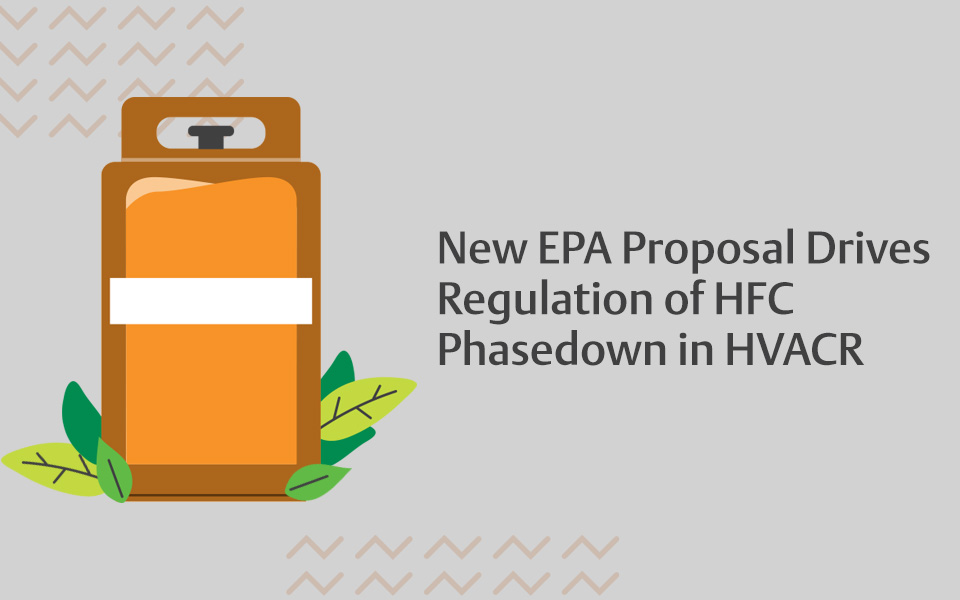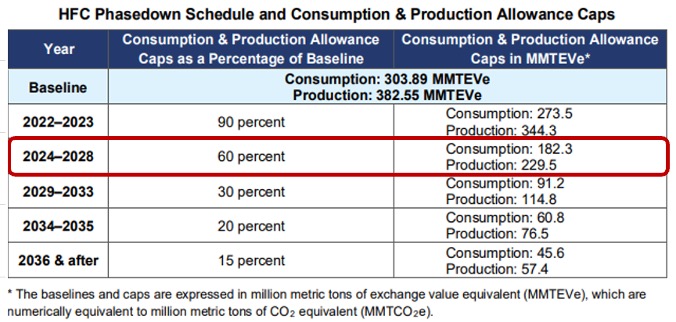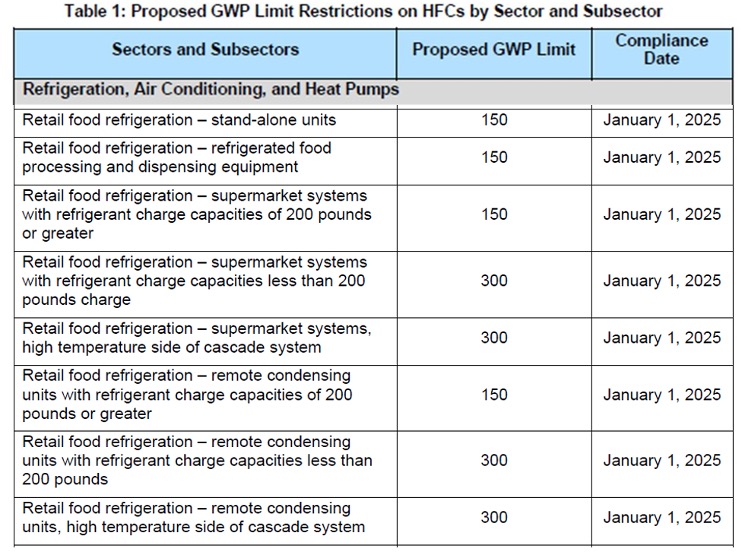*On June 1, 2023 Emerson’s Climate Technologies business became a new standalone company – Copeland. Though our name has changed, we are building on more than a century of HVACR innovation and industry leadership, and Copeland continues to offer the same products, industry stewardship, and learning opportunities you’ve grown to trust. Information found on this webpage posted before June 1, 2023 may contain our old name or branding, but you can be at ease knowing it was created with the knowledge and expertise of Copeland.
Since the passing of the American Innovation & Manufacturing Act (AIM Act) in 2020, the HVACR industry has anxiously awaited direction from the Environmental Protection Agency (EPA) on the framework of its hydrofluorocarbon (HFC) refrigerant phasedown. In December, the EPA put some of this uncertainty to rest, releasing a new proposal that, if approved, would mandate new global warming potential (GWP) limits across HVACR sectors. Although it aligns with many industry recommendations, the proposed compliance dates are earlier than expected: with low-GWP limits on new commercial refrigeration equipment (CRE) set to begin in 2025.

The EPA’s proposed HFC Technology Transitions Rule has many important implications for HVACR and related industries, many of which I’ve summarized in this blog. I’ve also been invited to speak on behalf of Women in HVACR at the upcoming AHR Expo in Atlanta on February 7 from 3–4 p.m. EST in booth 315, when I will provide a more detailed explanation.
Reviewing the larger regulatory context
When the AIM Act became a law in 2020, it aligned with the globally agreed-upon HFC phasedown schedule set forth by the Kigali Amendment to the Montreal Protocol — which calls for an 85 percent reduction in HFC supplies by 2036. To help the U.S. achieve these targets, the AIM Act authorizes the EPA to regulate the supply, demand and management of HFCs in three ways:
- Mandating HFC supply restrictions — In 2022, the EPA began its HFC phasedown by implementing a 10 percent reduction in production and consumption. The next step-downs are 40 percent in 2024 and 70 percent in 2029 — which will impact the current equipment install base by lowering available HFC refrigerant supplies and driving up prices.

- Establishing sector-based GWP limits — To reduce demand for HFCs in new equipment and systems, the EPA is permitted to restrict the use of regulated substances including legacy HFCs. This is the purpose of the recently proposed Technology Transition rulemaking. EPA is also authorized to approve the use of new lower-GWP alternatives per sector via its Significant New Alternatives Policy (SNAP) program.
- Regulating HFC management — Establishing and enforcing standards in servicing and repair best practices, such as: lowering leak rate thresholds and requiring proper recovery of “used” HFCs for purification and resale (aka reclaim).
Details of proposed Technology Transition rule and sector-based GWP limits
Following passage of the AIM Act, the EPA has received petitions from companies, states, non-governmental environmental organizations (NGOs) and industry associations regarding sector-specific GWP limits and transition timing. As a member of the Air-Conditioning, Heating, and Refrigeration Institute (AHRI), Emerson was among those who provided input. With a few notable exceptions, the new EPA proposal has taken much of this industry input into consideration.
In the retail food sector (i.e., commercial refrigeration), the proposal set the compliance date for updated GWP limits in new equipment to Jan. 1, 2025 — one year sooner than industry stakeholders had expected. However, the proposed GWP restrictions are consistent with AHRI recommendations and industry petitions, ranging from 150 to 300 GWP across the spectrum of CRE and systems.
The following EPA table summarizes the GWP limits per equipment:
Per the proposal, self-contained, automatic commercial ice machines (ACIMs) less than 500g would have a GWP limit of 150 and a compliance date of Jan. 1, 2025. If finalized as published, the proposed timing brings with it new compliance and market challenges for the entire commercial refrigeration supply chain:
- Manufacturers will need to qualify new equipment and systems for use with low-GWP refrigerants by 2025.
- End users will need to accelerate their transitions to technologies using low-GWP refrigerant alternatives.
- Service technicians will need to familiarize themselves with the operation and maintenance of these systems earlier.
Note: In response to this proposal, three notable sectors have already asked for more time and/or a higher-GWP limits: ACIM and soft serve (under the refrigerated food and processing equipment category), and data center cooling.
In the AC and heat pump sector, the EPA proposal calls for a Jan. 1, 2025, compliance date with a GWP limit of 700, rather than the 750 GWP recommendation proposed by industry stakeholders. Though unexpected, the lower-GWP limit should have marginal impacts on compliance or equipment design. Intermodal containers used transport refrigeration also have a proposed 700 GWP limit and a Jan. 1, 2025, compliance date.
The EPA proposal also will delay the expected compliance date on industrial process chillers to Jan. 1, 2025 — one year later than expected — mainly due to the 12-month minimum time required under the AIM Act. However, for states that have already adopted EPA SNAP Rule 21, they are expected to enforce the compliance date of Jan. 1, 2024.
The proposed rule would also prohibit the sale, distribution and export of products containing restricted HFCs one year after the compliance date, which in most cases would be Jan. 1, 2026. Please see the proposed rule for more details about the sectors that may impact your business.
Status of new refrigerant approvals
Although the EPA proposal identifies several acceptable lower-GWP substitutes for these sectors and their equipment types, they’re also in the process of reviewing other next-generation alternatives. The EPA uses its SNAP program — which was established under the Clean Air Act in response to the Montreal Protocol — to evaluate and approve new refrigerant alternatives. For example, previous SNAP rules have approved R-290 for use in low-charge, self-contained applications and lower-GWP HFCs like R-448A for remote condensing units.
Meeting the low-GWP restrictions below 150 and 300 GWP across a variety of CRE types will require the use of new refrigerant substitutes, including lower-flammability A2L refrigerants. In 2021, an update to the 2nd edition of the UL 60335-2-89 safety standard established new safe use and charge limit guidelines for flammable refrigerants, including A2L refrigerants and increased charges of R-290.
The EPA is currently working on a new SNAP proposal — SNAP Rule 26 — that would approve the use of A2L refrigerants and increase R-290 charges, which are currently limited to 150g. Per the UL 2-89 standard, R-290 charges could be increased to 300 and 500g, per application guidelines. With their lower flammability classification, A2Ls would not only be allowed in much higher charges, but also be applicable across a much wider range of CRE. The proposed SNAP Rule 26 is expected to be announced in the next few months.
Emerson is committed to helping our customers through this important refrigerant transition and keeping the industry informed of the latest rulemaking. Please visit the regulations section of our content hub for more information and be sure to check our blog for updates as new rules are proposed.

8 proven strategies for rigorous cold chain management
Preparing for the approval and safe use of A2Ls in commercial refrigeration applications...
Protection for high-value shipments just got even better
We’re excited to announce the release of Copeland’s newest real-time tracker, the GO Real-Time...

Three proven strategies to prevent cargo theft
The over-the-road (OTR) transport industry is experiencing a surge in cargo thefts. As thieves...
